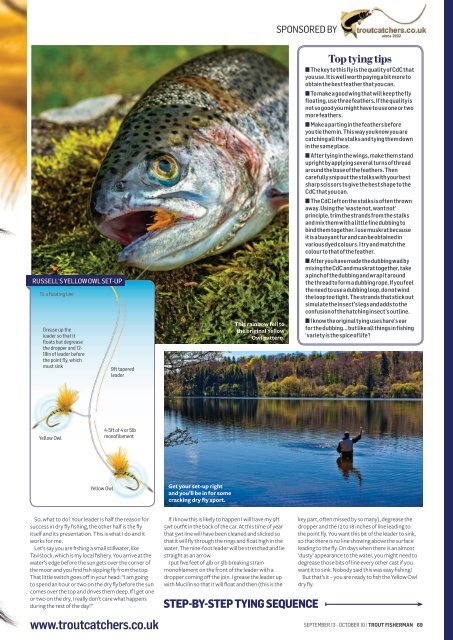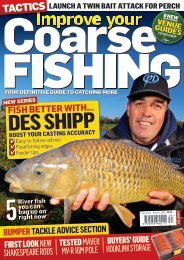Trout Fisherman
You also want an ePaper? Increase the reach of your titles
YUMPU automatically turns print PDFs into web optimized ePapers that Google loves.
SPONSORED BY<br />
RUSSELL’S YELLOW OWL SET-UP<br />
To a floating line<br />
Grease up the<br />
leader so that it<br />
floats but degrease<br />
the dropper and 12-<br />
18in of leader before<br />
the point fly, which<br />
must sink<br />
9ft tapered<br />
leader<br />
This rainbow fell to<br />
the original Yellow<br />
Owl pattern.<br />
Top tying tips<br />
■ The key to this fly is the quality of CdC that<br />
you use. It is well worth paying a bit more to<br />
obtain the best feather that you can.<br />
■ To make a good wing that will keep the fly<br />
floating, use three feathers. If the quality is<br />
not so good you might have to use one or two<br />
more feathers.<br />
■ Make a parting in the feathers before<br />
you tie them in. This way you know you are<br />
catching all the stalks and tying them down<br />
in the same place.<br />
■ After tying in the wings, make them stand<br />
upright by applying several turns of thread<br />
around the base of the feathers. Then<br />
carefully snip out the stalks with your best<br />
sharp scissors to give the best shape to the<br />
CdC that you can.<br />
■ The CdC left on the stalks is often thrown<br />
away. Using the ‘waste not, want not’<br />
principle, trim the strands from the stalks<br />
and mix them with a little fine dubbing to<br />
bind them together. I use muskrat because<br />
it is a buoyant fur and can be obtained in<br />
various dyed colours. I try and match the<br />
colour to that of the feather.<br />
■ After you have made the dubbing wad by<br />
mixing the CdC and muskrat together, take<br />
a pinch of the dubbing and wrap it around<br />
the thread to form a dubbing rope. If you feel<br />
the need to use a dubbing loop, do not wind<br />
the loop too tight. The strands that stick out<br />
simulate the insect’s legs and adds to the<br />
confusion of the hatching insect’s outline.<br />
■ I know the original tying uses hare’s ear<br />
for the dubbing... but like all things in fishing<br />
‘variety is the spice of life’!<br />
Yellow Owl<br />
4-5ft of 4 or 5lb<br />
monofilament<br />
Yellow Owl<br />
Get your set-up right<br />
and you’ll be in for some<br />
cracking dry fly sport.<br />
So, what to do? Your leader is half the reason for<br />
success in dry fly fishing, the other half is the fly<br />
itself and its presentation. This is what I do and it<br />
works for me.<br />
Let’s say you are fishing a small stillwater, like<br />
Tavistock, which is my local fishery. You arrive at the<br />
water’s edge before the sun gets over the corner of<br />
the moor and you find fish sipping fly from the top.<br />
That little switch goes off in your head: “I am going<br />
to spend an hour or two on the dry fly before the sun<br />
comes over the top and drives them deep. If I get one<br />
or two on the dry, I really don’t care what happens<br />
during the rest of the day!”<br />
www.troutcatchers.co.uk<br />
If I know this is likely to happen I will have my 9ft<br />
5wt outfit in the back of the car. At this time of year<br />
that 5wt line will have been cleaned and slicked so<br />
that it will fly through the rings and float high in the<br />
water. The nine-foot leader will be stretched and lie<br />
straight as an arrow.<br />
I put five feet of 4lb or 5lb breaking strain<br />
monofilament on the front of the leader with a<br />
dropper coming off the join. I grease the leader up<br />
with Mucilin so that it will float and then (this is the<br />
STEP-BY-STEP TYING SEQUENCE<br />
key part, often missed by so many), degrease the<br />
dropper and the 12 to 18 inches of line leading to<br />
the point fly. You want this bit of the leader to sink,<br />
so that there is no line showing above the surface<br />
leading to the fly. On days when there is an almost<br />
‘dusty’ appearance to the water, you might need to<br />
degrease those bits of line every other cast if you<br />
want it to sink. Nobody said this was easy fishing!<br />
But that’s it – you are ready to fish the Yellow Owl<br />
dry fly.<br />
SEPTEMBER 13 - OCTOBER 10 | TROUT FISHERMAN 69

















